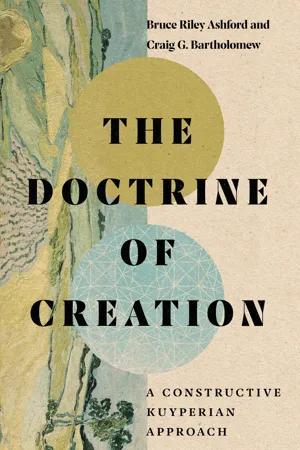
The Doctrine of Creation
A Constructive Kuyperian Approach
- 448 pages
- English
- ePUB (mobile friendly)
- Available on iOS & Android
About this book
Christianity Today Book Award
ECPA Top Shelf Book Cover Award
Apart from the doctrine of God, no doctrine is as comprehensive as that of creation. It is woven throughout the entire fabric of Christian theology. It goes to the deepest roots of reality and leaves no area of life untouched. Across the centuries, however, the doctrine of creation has often been eclipsed or threatened by various forms of gnosticism. Yet if Christians are to rise to current challenges related to public theology and ethics, we must regain a robust, biblical doctrine of creation.
According to Bruce Ashford and Craig Bartholomew, one of the best sources for outfitting this recovery is Dutch neo-Calvinism. Abraham Kuyper, Herman Bavinck, and their successors set forth a substantial doctrine of creation's goodness, but recent theological advances in this tradition have been limited. Now in The Doctrine of Creation Ashford and Bartholomew develop the Kuyperian tradition's rich resources on creation for systematic theology and the life of the church today.
In addition to tracing historical treatments of the doctrine, the authors explore intertwined theological themes such as the omnipotence of God, human vocation, and providence. They draw from diverse streams of Christian thought while remaining rooted in the Kuyperian tradition, with a sustained focus on doing theology in deep engagement with Scripture.
Approaching the world as God's creation changes everything. Thus The Doctrine of Creation concludes with implications for current issues, including those related to philosophy, science, the self, and human dignity. This exegetically grounded constructive theology contributes to renewed appreciation for and application of the doctrine of creation—which is ultimately a doctrine of profound hope.
Frequently asked questions
- Essential is ideal for learners and professionals who enjoy exploring a wide range of subjects. Access the Essential Library with 800,000+ trusted titles and best-sellers across business, personal growth, and the humanities. Includes unlimited reading time and Standard Read Aloud voice.
- Complete: Perfect for advanced learners and researchers needing full, unrestricted access. Unlock 1.4M+ books across hundreds of subjects, including academic and specialized titles. The Complete Plan also includes advanced features like Premium Read Aloud and Research Assistant.
Please note we cannot support devices running on iOS 13 and Android 7 or earlier. Learn more about using the app.
Information

The Doctrine of Creation as an Article of Faith
- the relation between the Father, “the maker of all things,” and the Son, “through whom all things came to be”
- the relation between God and creation
- the relation between heaven and earth5
Table of contents
- Cover
- Title Page
- Dedication Page
- Contents
- Preface
- Acknowledgments
- Abbreviations
- Introduction
- 1 I/We Believe: The Doctrine of Creation as an Article of Faith
- 2 The Travails and Glories of the Doctrine of Creation: Early Church to Post-Reformation
- 3 The Travails and Glories of the Doctrine of Creation: The Modern Period
- 4 God the Father Almighty
- 5 Laying the Foundations: The Furnishing of the Creation
- 6 Place, Plants, Animals, Humans, and Creation
- 7 The Heavenly Realm
- 8 Sabbath, Fall, and Misdirection
- 9 Creation and Culture
- 10 Creatio Continua: Providence and History
- 11 Creation, Christ, the Spirit, and the New Creation
- 12 Creation and . . .: Caveats on the Implications of the Doctrine of Creation
- Appendix: Contours of Missional Neo-Calvinism, by Michael Goheen and Craig Bartholomew
- Bibliography
- Name Index
- Subject Index
- Scripture Index
- Notes
- Praise for The Doctrine of Creation
- About the Authors
- More Titles from InterVarsity Press
- Copyright